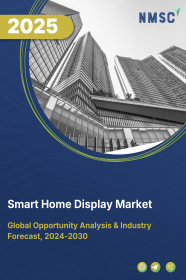
Singapore Smart Display Market by Display Technology (LCD, LED, E-Paper Display, and Other Display Technologies), by Type (Standalone Smart Displays, Integrated Smart Displays, Interactive Touchscreen Displays, Transparent Smart Displays, and Other Display Types), by Display Size (Below 24 Inch, 24 Inch to 55 Inch, and Above 55 Inch), by Resolution (UHD, FHD, HD, and Others) and Others– Opportunity Analysis and Industry Forecast, 2023–2030
Industry: Semiconductor & Electronics | Publish Date: 14-Feb-2025 | No of Pages: 81 | No. of Tables: 63 | No. of Figures: 26 | Format: PDF | Report Code : SE1034
US Tariff Impact on Singapore Smart Display Market
Trump Tariffs Are Reshaping Global Business
Market Definition
Singapore Smart Display Market was valued at USD 305.29 million in 2022, and is predicted to reach USD 1294.8 million by 2030, with a CAGR of 18.2% from 2023 to 2030. A smart display is a sophisticated device featuring a touchscreen or interactive visual interface, coupled with voice recognition and artificial intelligence capabilities.
Functioning as versatile information hubs, these displays can execute diverse tasks, including presenting information and managing smart home devices. They offer visual responses to voice commands, facilitating video calls and serving as interactive tools for scheduling, weather updates, and entertainment purposes.
Smart displays are meticulously crafted to elevate convenience, accessibility, and user engagement across various settings, such as homes, offices, and public spaces. Their applications span residential homes, offices, healthcare facilities, retail, education, and beyond.
Smart Homes Driving Demand: The Rise of Smart Displays in Home Automation
The surge in smart home adoption, fueled by the pursuit of convenience and energy efficiency, is amplifying the demand for smart displays. These versatile devices are emerging as essential components of home automation systems, seamlessly integrating into modern lifestyles. As homeowners increasingly seek interconnected and intelligent solutions, smart displays play a pivotal role in enhancing control, offering a user-friendly interface for managing smart devices, and contributing to the overall efficiency and comfort of smart homes.
Connecting the Dots: Smart Displays Riding the Wave of High-Speed Connectivity
With the expansion of high-speed internet infrastructure, there is a surging demand for connected devices, and smart displays are leading the charge in this digital revolution. These devices leverage enhanced connectivity, providing smooth access to a variety of services such as information, entertainment, and communication.
In an age where staying connected is crucial, smart displays become essential instruments, effectively bridging the gap between users and a realm of digital possibilities. Therefore it is expected to boost the growth of the market within the country.
Security Vulnerabilities in Smart Home Displays Restrain Market Growth
Security vulnerabilities in smart display technology represent a significant restraining factor for the smart display market. The potential for security breaches in smart displays poses a substantial risk to users. Insufficient security measures, such as weak passwords and inadequate encryption, could lead to the exposure of sensitive data. Therefore, it is imperative for manufacturers to prioritize robust security features within smart displays, including strong authentication methods and prompt vulnerability patching through regular updates.
Unveiling Opportunities: The Introduction of Laser-Based Display Technology
Laser-based display technology is presenting substantial opportunities within the smart display market. Its exceptional brightness, color accuracy, long-lasting durability, and energy efficiency position it as a prime choice for diverse applications, spanning from home theaters to outdoor signage and augmented reality experiences.
The extended lifespan and reliability of laser-based displays result in reduced maintenance costs and align with sustainability objectives. As this technology becomes increasingly accessible and cost-effective, it is instigating innovation in the realm of smart displays, particularly in sectors where top-tier visual quality and energy conservation are paramount, thus broadening the market's potential for expansion.
Competitive Landscape
The Singapore smart display industry includes several market players such as Samsung Electronics, Qisda Corporation (BenQ), LG Corporation, Sharp Corporation, Lenovo Group Limited, Alps Alpine Co., Ltd, Sony Corporation, Google, LLC., Leyard Optoelectronic Co., and Amazon.com, Inc.
Key Benefits
-
The Singapore smart display market report provides a quantitative analysis of the current market and estimations through 2023-2030 that assists in identifying the prevailing market opportunities to capitalize on.
-
The study comprises a deep dive analysis of the market trend including the current and future trends for depicting the prevalent investment pockets in the market.
-
The information related to key drivers, restraints, and opportunities and their impact on the market is provided in the report.
-
The competitive analysis of the market players along with their market share in the Singapore smart display market.
-
The SWOT analysis and Porter’s Five Forces model are elaborated in the study.
-
Value chain analysis in the market study provides a clear picture of the stakeholders’ roles.
Singapore Smart Display Market Key Segments
By Display Technology
-
LCD
-
LED
-
E-Paper Displays
-
Other Display Technologies
By Type
-
Standalone Smart Displays
-
Integrated Smart Displays
-
Interactive Touchscreen Displays
-
Transparent Smart Displays
-
Other Display Types
By Display Size
-
Below 24 inch
-
24 inch to 55 inch
-
Above 55 inch
By Resolution
-
UHD
-
FHD
-
HD
-
Others
By Sales Channel
-
Direct Sales
-
Retailers and Distributors
-
E-Commerce Or Online Sales
By Application
-
Smart Home
-
Digital Signage
-
Automotive
-
Healthcare
-
Other Applications
REPORT SCOPE AND SEGMENTATION:
|
Parameters |
Details |
|
Market Size in 2022 |
USD 305.29 Million |
|
Revenue Forecast in 2030 |
USD 1294.8 Million |
|
Growth Rate |
CAGR of 18.2% from 2023 to 2030 |
|
Analysis Period |
2022–2030 |
|
Base Year Considered |
2022 |
|
Forecast Period |
2023–2030 |
|
Market Size Estimation |
Million (USD) |
|
Growth Factors |
Expansion of high-speed internet infrastructure The rise of smart displays in home automation. |
|
Companies Profiled |
10 |
|
Market Share |
Available for 10 companies |
|
Customization Scope |
Free customization (equivalent up to 80 working hours of analysts) after purchase. Addition or alteration to country, regional, and segment scope. |
|
Pricing and Purchase Options |
Avail customized purchase options to meet your exact research needs. |
KEY PLAYERS
-
Samsung Electronics
-
Qisda Corporation (BenQ)
-
LG Corporation
-
Sharp Corporation
-
Lenovo Group Limited
-
Alps Alpine Co., LTD
-
Sony Corporation
-
Google, LLC.
-
Leyard Optoelectronic Co
-
Amazon.com, Inc.

















 Speak to Our Analyst
Speak to Our Analyst



















